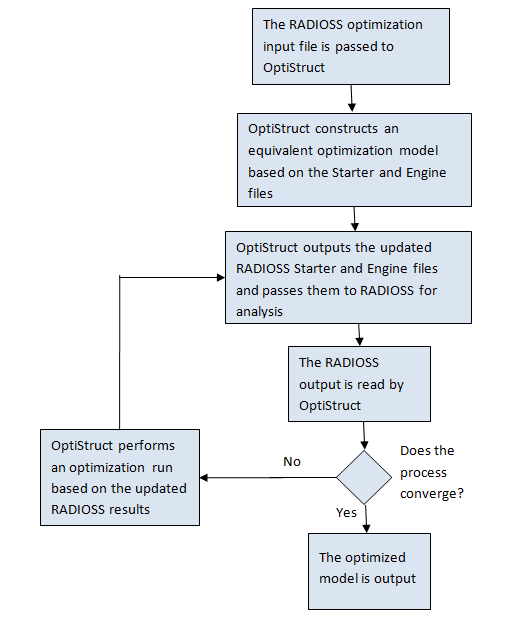Optimization Process
Radioss parses all three decks (optimization, Starter and Engine decks) to construct an optimization model. For each optimization iteration, an updated/optimized Starter file (<name>_rad_s#_i###_0000.rad) and Engine file (<name>_s#_i###_0001.rad) will be written out, where ### is the optimization iteration number.

Figure 1. Optimization in Radioss Process Overview
Implementation Sequence
- Pass the optimization file <name>.radopt to OptiStruct using the syntax specified in Optimization Process. OptiStruct will automatically search for <name>_0000.rad and <name>_0001.rad in the same directory.
- OptiStruct parses the Radioss input files, constructs an equivalent OptiStruct model, and continues with the execution of this OptiStruct model.
- OptiStruct applies the optimized design variables and writes out the updated/optimized Radioss Starter/Engine files (<name>_rad_s#_i###_0000.rad and <name>_s#_i###_0001.rad). In the first outer loop, the design variables are not updated yet, and the Starter/Engine files will be identical to the initial user input.
- Radioss solves the updated Starter/Engine files generated in Step 3.
- OptiStruct reads the Radioss results obtained in Step 4 and starts the next optimization run (inner loop).
- If the results from Radioss vary beyond the threshold as compared to the previous outer loop, then the optimization process did not converge.
- The optimization process is then continued (using the ESLM method) on the updated results from the Radioss analysis and new optimized design variables are generated. Steps 3 to 6 are repeated to verify if the process converges after the subsequent iteration. If convergence is achieved, go to Step 8.
- The process ends and
optimized results are output.

Figure 2. Optimization Sequence in Radioss and OptiStruct